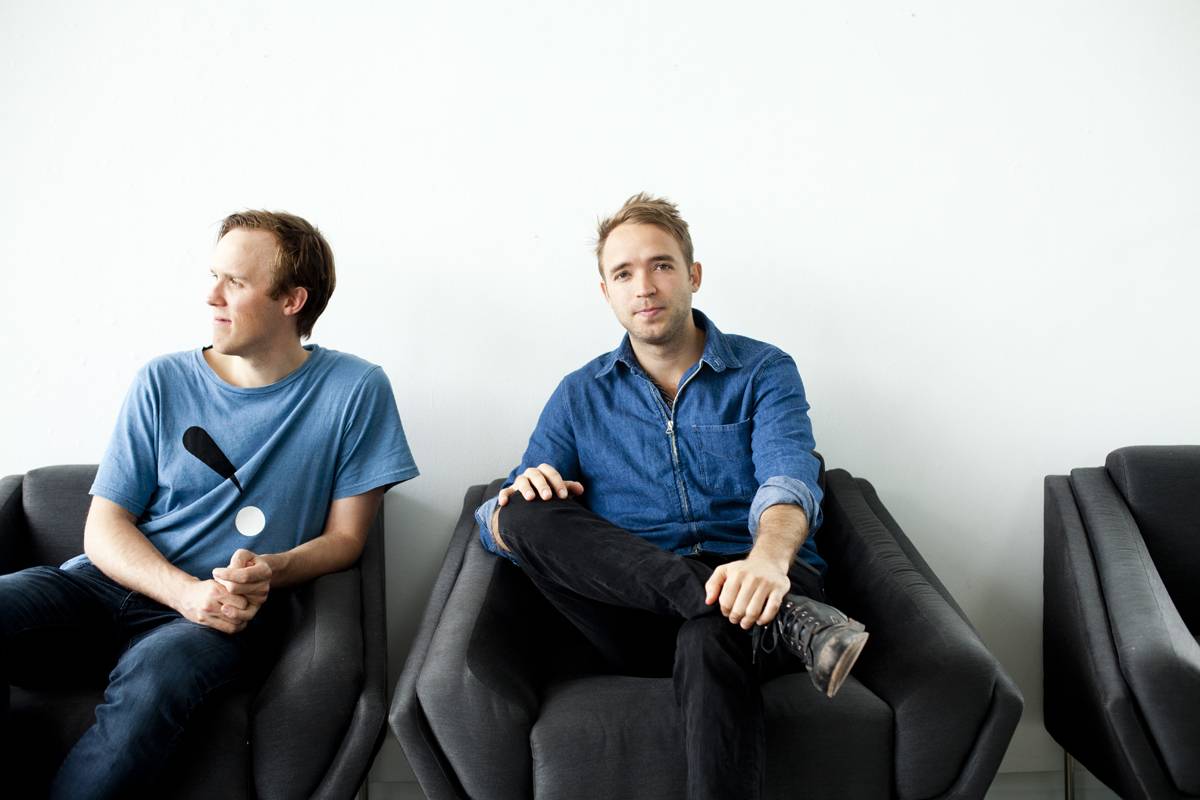At Tuck, a Band of Brothers
A conversation with T’16s Johnny and Pete Mathias—MBAs, entrepreneurs, and members of the band Filligar.

A conversation with T’16s Johnny and Pete Mathias—MBAs, entrepreneurs, and members of the band Filligar.
Brothers Johnny and Pete Mathias are legitimate rock stars in every way. Guitarist and drummer, respectively, for the band Filligar, the second-year Tuck students aren’t twins, but they share many things, including a love of music and a keen interest in the discipline of business. Their work as U.S. State Department cultural ambassadors has taken them and their bandmates—brother Teddy Mathias on bass and friend Casey Gibson on keyboards—to Azerbaijan, Kuwait, Guyana, and, most recently, Russia, while their new entrepreneurial venture, Heartstring, is taking user-generated videos to the next level. We caught up with Johnny and Pete to learn more about their cultural outreach, their startup, Heartstring, and their futures and the future of music.
Tell us about your cultural ambassadorship.
Johnny: For the past several years, we’ve served as cultural envoys, the result of an early relationship that started after a member of the State Department’s cultural outreach program saw one of our shows at SXSW in Austin, Texas. Our first project with the program was a radio show we did from the U.S. with Planet 94 in Islamabad, Pakistan. That went well, and a month later the State Department called and said, We want to send you all to Azerbaijan. And that trip in 2013 was our first formal trip as ambassadors.
What do you do as part of these trips?
Johnny: Our responsibilities are varied. We’re there as performers, playing at rock concerts, festivals, and smaller settings. And we do community outreach, which could mean anything from doing master classes on a wide variety of subjects—music history, the mechanics of blues, and rock and roll music—to going to open mic nights and being part of the conversation with youth musicians and even some professional musicians.
How was your trip to Russia?
Johnny: We were in Russia for eight days, in both metropolitan and rural settings. We spent some time in the city of Yekaterinburg and then went out into the countryside for a few days before coming back to the city.
Pete: When we went out into the country, we stayed with people who live entirely off the land, and who have created wonderful businesses based on environments that are very different from the kind we see in the U.S. And they’ve been highly productive and very happy.
Dean Matthew Slaughter talks about aspiring to use business as a force for good. Do you see music as a way to do this?
Johnny: The purpose of the cultural ambassadors program is to foster cross-cultural understanding through the universal language of music. And to respond more directly to what Dean Slaughter’s talking about, yes, part of this trip was also about answering the question of how you can surround the creative world of the arts with the discipline of business.
Pete: If you ask most musicians, music and the business of music are like the separation of church and state. I mean, people are into music because they love music. But the more the business side becomes embraced, it opens up a world of opportunity for those who love music, either as creators of it or fans of it.
What is your startup, Heartstring?
Johnny: Heartstring was a project in E-Think, the Entrepreneurial Thinking course. The app allows users to easily pair high-quality soundtracks to their visual content with the swipe of a finger. Heartstring additionally serves marketers who have a need for efficient access to cost-effective, legally cleared music to complement their ever-increasing volume of brand touchpoints.
We knew that music licensing is a big part of music. And we also knew that we’re much more sensitive now to the broader trends in tech, moving away from desktop toward mobile.
Pete: Heartstring started off with what we already know about the music business. And we had learned really early on—when we visited iTunes as it was coming out to have them distribute our music, or when we beta-tested YouTube in its early days—how compelling licensing is as part of it. Heartstring brings music alongside the creative output of an individual on social media or of a brand.
For consumers, Heartstring pairs music to their own user-generated content, to make their images, their videos, pop.
Johnny: Giving the everyday social photo creator what Hollywood studios have had all along, which is the cinematic power of expressive music.
Pete: For the enterprise customer, it would be a more cost-effective solution for providing a soundtrack for their media.
You have your music, you’ll have your MBAs, you have your startup—where do you see yourselves in 10 years?
Pete: I’m doing a fellowship now with .406 Ventures and will be finishing my MPA at the Kennedy School at Harvard, and Johnny’s going to Harris Williams, where he’ll be looking at some of the bigger middle-market deals that are part of media and tech today.
Johnny: The vision for what we’re doing in ten years is pretty simple—and I think it’s shared by almost everyone—and that’s to wake up every morning and do what we love. For us it’s music, and I think that what’s exciting about being at Tuck is that whether people already have a vision for themselves or are still figuring it out, it’s a great platform for getting to any goal.
Pete: We want to have a business that’s a good business. What really gets us excited is creating something that’s cool and working with people who continually teach us things that we don’t know. And Tuck is an awesome place to do that because there’s a wealth of practitioners, professors, and people here who all contribute to the enthusiasm about a project.
For more information about Filligar—including their upcoming show at Bowery Ballroom in New York City on May 27th—visit www.filligar.com. For information about Heartstring, visit www.heartstring.life or https://vimeo.com/153527564.
